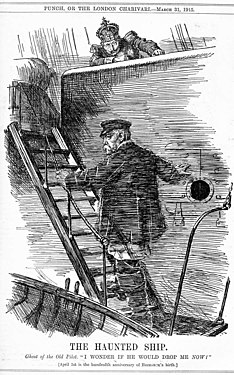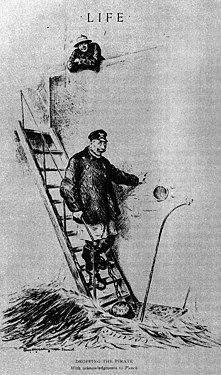Dropping the Pilot
Dropping the Pilot is a political cartoon by Sir John Tenniel, first published in the British magazine Punch on 29 March 1890.[1] It depicts Chancellor Otto von Bismarck as a maritime pilot who is stepping off a ship, perhaps a reference to Plato's ship of state,[1] idly and unconcernedly watched by a young Wilhelm II, German Emperor. Bismarck had resigned as Chancellor at Wilhelm's demand just ten days earlier on 19 March[2][3] because of political differences.
After the cartoon's publication, Tenniel received a commission from the 5th Earl of Rosebery to create a copy to be sent to Bismarck himself. The former chancellor reportedly replied, "It is indeed a fine one".[4]
The cartoon is well known in Germany and often used in history textbooks and school books, under the title The Pilot Leaves the Ship (German: Der Lotse geht von Bord).[1]
Adaptations[]

Prophecy? (Dropping the Pilot) by Will Dyson, 1914

The Haunted Ship by Bernard Partridge, 1915

Dropping the Pirate by William H. Walker, 1918
- Dropping the pilot, referring to Kaiser Wilhelm's removal from the list of Royal Navy admirals in 1914, by David Low[5]
- Dropping the pilot, referring to Winston Churchill, by [6]
- Cartoon Dropping the Pilots showing Khrushchev looking down as the four "Pilots" leave the ship of state.
- Cartoon showing the pilot Abraham Lincoln being "Dropped" from the "Grand Old Party" By Captain Barry Goldwater
- Cartoon showing Margaret Thatcher being "Dropped as the Pilot"
- Steve Bell of The Guardian has adapted the cartoon:
- Vice-president faces isolation after key ally leaves Pentagon[7]
- Iraqis celebrate the withdrawal of American combat troops[8]
- David Cameron's response to Coulson's guilt[9]
- Dropping the pornbot (Resignation of Damian Green)[10]
- Martin Rowson of The Guardian has also adapted the cartoon repeatedly:
References[]
- ^ Jump up to: a b c d "Dropping the Pilot (1890)". Wilhelmine Germany and the First World War (1890-1918). German History in Documents and Images (GHDI). Retrieved 1 March 2014. "Here, we see a weary Bismarck descending the ladder of the 'ship' Germany, which he had steered for almost 20 years as chancellor. A young Wilhelm II looks on from the deck".
- ^ The Times, London: Times Newspapers Ltd., 19 March 1890.
- ^ The New York Times, New York: The New York Times Company, 19 March 1890.
- ^ Engen, Rodney K. Sir John Tenniel: Alice's White Knight, Aldershot, Hants, England: Scolar Press, 1991, 140–142.
- ^ Low, David. "Dropping the Pilot". politicalcartoon.co.uk. Retrieved 8 July 2010.[dead link]
- ^ . "Dropping the Pilot". Library of Congress. Retrieved 8 July 2010.
- ^ Bell, Steve (10 November 2006). "Vice-president faces isolation after key ally leaves Pentagon". The Guardian. Retrieved 8 July 2010.
- ^ Bell, Steve (1 July 2009). "Iraqis celebrate the withdrawal of American combat troops". The Guardian. Retrieved 8 July 2010.
- ^ Bell, Steve (25 June 2014). "David Cameron's response to Coulson's guilt". The Guardian. Retrieved 6 July 2014.
- ^ Bell, Steve. "Steve Bell on Damian Green's resignation – cartoon". The Guardian. Retrieved 22 December 2017.
- ^ Rowson, Martin (5 March 2012). "Martin Rowson on Steve Hilton's exit". Guardian Opinion cartoon. The Guardian. Retrieved 5 March 2012.
- ^ Rowson, Martin (7 December 2014). "Martin Rowson on Alex Salmond standing in the 2015 general election". Guardian Opinion cartoon. The Guardian. Retrieved 7 December 2014.
- ^ Rowson, Martin (14 February 2017). "Martin Rowson on the resignation of Michael Flynn". Guardian Opinion cartoon. The Guardian. Retrieved 14 February 2017.
- 1890 works
- Cultural depictions of Otto von Bismarck
- Cultural depictions of Wilhelm II
- Editorial cartoons
- Works originally published in Punch (magazine)



